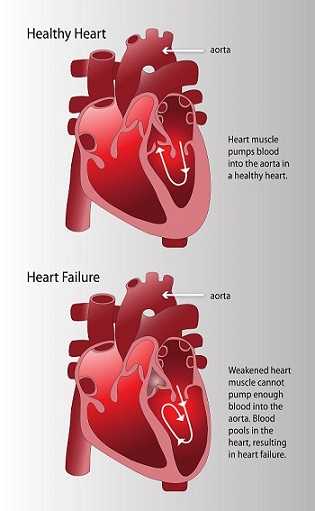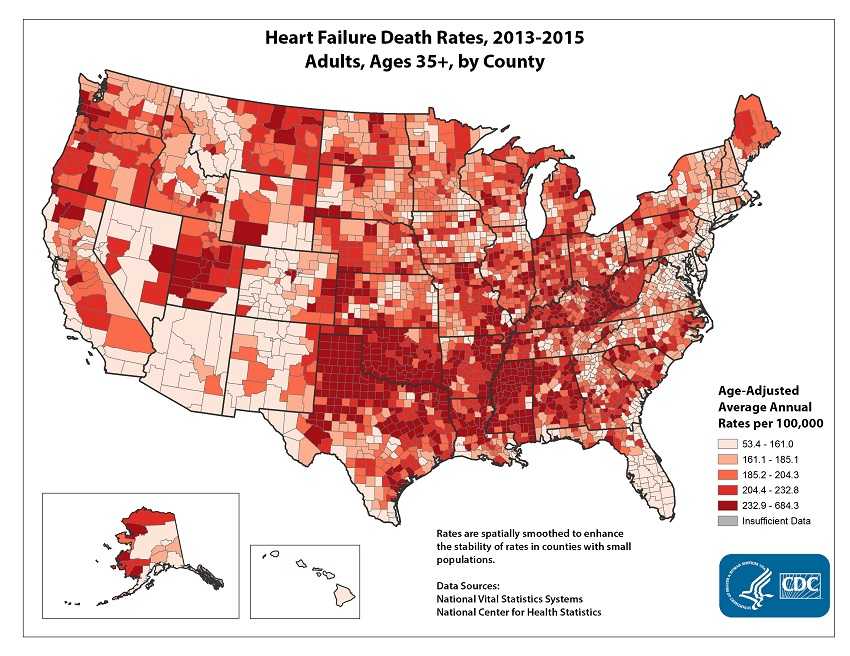Heart Failure Fact Sheet

Heart failure happens when the heart cannot pump enough blood and oxygen to support other organs in your body. Heart failure is a serious condition, but it does not mean that the heart has stopped beating.
Heart Failure in the United States
- About 5.7 million adults in the United States have heart failure.1
- One in 9 deaths in 2009 included heart failure as contributing cause.1
- About half of people who develop heart failure die within 5 years of diagnosis.1
- Heart failure costs the nation an estimated $30.7 billion each year.3 This total includes the cost of health care services, medications to treat heart failure, and missed days of work.
Deaths from Heart Failure Vary by Geography
Heart failure is more common in some areas of the United States than in others. Below is a map showing the rate of death from heart failure by county during 2011–2013.
Risk Factors for Heart Failure
Diseases that damage your heart also increase your risk for heart failure. Some of these diseases include
- Coronary heart disease (the most common type of heart disease) and heart attacks.
- High blood pressure.
- Diabetes.
Unhealthy behaviors can also increase your risk for heart failure, especially for people who have one of the diseases listed above. Unhealthy behaviors include
- Smoking tobacco.
- Eating foods high in fat, cholesterol, and sodium.
- Not getting enough physical activity.
- Being obese.
Signs and Symptoms of Heart Failure

Common symptoms of heart failure include:
- Shortness of breath during daily activities.
- Having trouble breathing when lying down.
- Weight gain with swelling in the feet, legs, ankles, or stomach.
- Generally feeling tired or weak.
Treating Heart Failure
Early diagnosis and treatment can improve quality and length of life for people who have heart failure. Treatment usually involves taking medications, reducing sodium in the diet, and getting daily physical activity. People with heart failure also track their symptoms each day so that they can discuss these symptoms with their health care team.
CDC’s Public Health Efforts Related to Heart Failure
Web Sites with More Information About Heart Failure
For more information about heart failure, visit the following Web sites:
- Medline Plus
- National Heart, Lung, and Blood Institute
- American Heart Association
- Heart Failure Society of America
References
- Mozzafarian D, Benjamin EJ, Go AS, et al. on behalf of the American Heart Association Statistics Committee and Stroke Statistics Subcommittee. Heart disease and stroke statistics—2016 update: a report from the American Heart Association. Circulation. 2016;133:e38-e360.
- Kochanek KD, Xu JQ, Murphy SL, Miniño AM, Kung HC. Deaths: final data for 2009 [PDF-3M]. Natl Vital Stat Rep. 2011;60(3).
- Heidenreich PA, Trogdon JG, Khavjou OA, Butler J, Dracup K, Ezekowitz MD, et al. Forecasting the future of cardiovascular disease in the United States: a policy statement from the American Heart Association. Circulation. 2011;123(8):933–44.
- Page last reviewed: June 16, 2016
- Page last updated: June 16, 2016
- Content source:



 ShareCompartir
ShareCompartir
